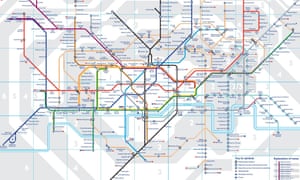We’ve seen plenty of alternative maps of the London Underground, from those plotting average rents by station, to those charting life expectancy at every stop. But what about sound? A group of musicians and sound artists have this week launched the first ever interactive “sound map” of the London Underground, capturing the shrieks, grinds and general patter of 55 tube stations across the capital.
It’s a noisy old world down there – from the “mind the gap” announcements to Londoners’ idiosyncratic curses and drunken late night conversations over illicit tinnies. This is precisely what The Next Station project, the work of Cities and Memory and The London Sound Survey, spent three months earlier this year gathering. And as well as capturing the real-life aural experience, sound artists from around the world were then invited to remix and reimagine the field recordings and create an alternative sound map to complement the real one – you can listen to all of them in one interactive feature.
So why make a sound map of the places we would all rather spend as little time thinking about as possible? Stuart Fowkes, a sound artist and the project’s creator, says London’s underground noises are iconic: “not just nationally but on a global scale” – for residents, tourists, and watchers of London-based films alike. The tube, Fowkes says, defines London in a way that public transport networks in other cities don’t.
Clicking through the sound map, you’ll hear a surprising range of noises: a didgeridoo player at Stratford, someone offering free hugs at Brixton and a bagpipe busker at King’s Cross – as well as all the announcements and clattering train noises that you’d expect. “You might think that one underground station sounds much like another,” says Fowkes, “but they’re as characterful as pet dogs once you get to know them.” King’s Cross would be a yappy terrier, then. Brixton an affectionate labrador.

And sound matters – what we hear every day on our commute is as much a part of our quotidian experience as our morning coffee. There’s the impact loud noises can have on our ears, for one. An expert working in 2004 recorded sound levels louder than a pneumatic drill on parts of the tube – loud enough to damage the hearing.
Then there’s also the psychological impact of sound: though we might classify many of the noises on the tube as stressful, Fowkes insists they can be reassuring in their familiarity, keeping the whole system moving like clockwork: “the details like the intonation of the automated announcements communicate ‘everything is well’ to commuters subconsciously … the trundle of the escalators, the closing of the sliding doors are all as rhythmic as a heartbeat, and become part of Londoners’ natural functions when they’re underground.”
This idea of the importance of acoustic ecology is not new – R Murray Schafer, considered the father of the debate around it, began talking about the (damaging) effects of sound, especially on people dwelling in the “sonic sewers” he believed cities to be, back in the 1970s. “Noises are the sounds we have learned to ignore,” he wrote. So perhaps this focus on the tube’s sounds will help Londoners’ occasionally listen, as well as simply hear, the underground aural landscape.

“There’s no blue plaque system for preserving important sounds”, Fowkes says, even though “sounds change as much as visual cityscapes, and today’s sounds are tomorrow’s history.” Perhaps it makes sense that we should be working to archive the soon-to-be-lost sounds of our cities.
The remixed sounds on the London Underground sound map – added to “help people to appreciate how sound can form source material for some interesting art,” Fowkes says – are intriguing, if a little high concept. With the field recording made at Piccadilly Circus, Swedish sound artist Anya Trybala has crafted a composition meant to be a meditation on Brexit. Composer and artist Martin A. Smith has reimagined Moorgate by mixing recordings the Northern line with the sound of cigales and church bells recorded in forests in Provence.
And with the tube now rumbling through the night into the early hours, will we see this soundscape changing? “From a field recording perspective, the night tube is really exciting,” Fowkes says. He’s planning to head out, recorder in hand, and capture some of these nocturnal tube sounds. Who wouldn’t want to hear Londoners’ late night, post-party deep and meaningfuls mixed over the sound of Provençal cicadas?
Cities and Memory is continuing to capture sounds, not just below ground, but also above ground in London and in other cities in 55 countries across the globe. Fowkes’ ambition is to “help people appreciate the joy of the sounds that surround them every day.” So maybe then we can stop grimacing at the shriek of the Victoria line as it passes through Pimlico? Perhaps not. But maybe we can look more kindly on that King’s Cross bagpiper at quarter to nine on a Monday morning.
Listen to the London Underground sound map here. Follow Guardian Cities on Twitter and Facebook to join the discussion
A journey through the first ever sound map of the London Underground
Hiç yorum yok:
Yorum Gönder